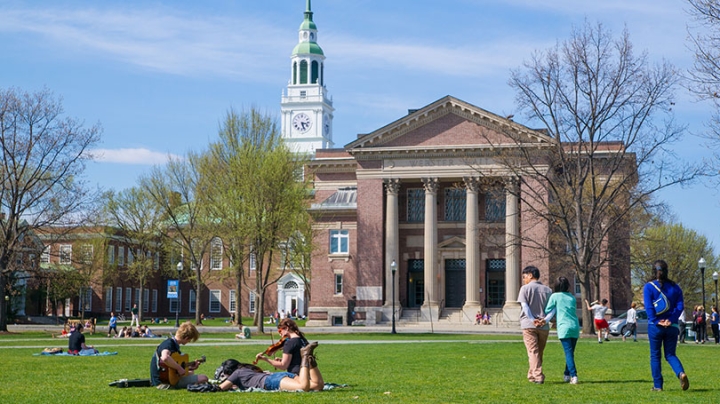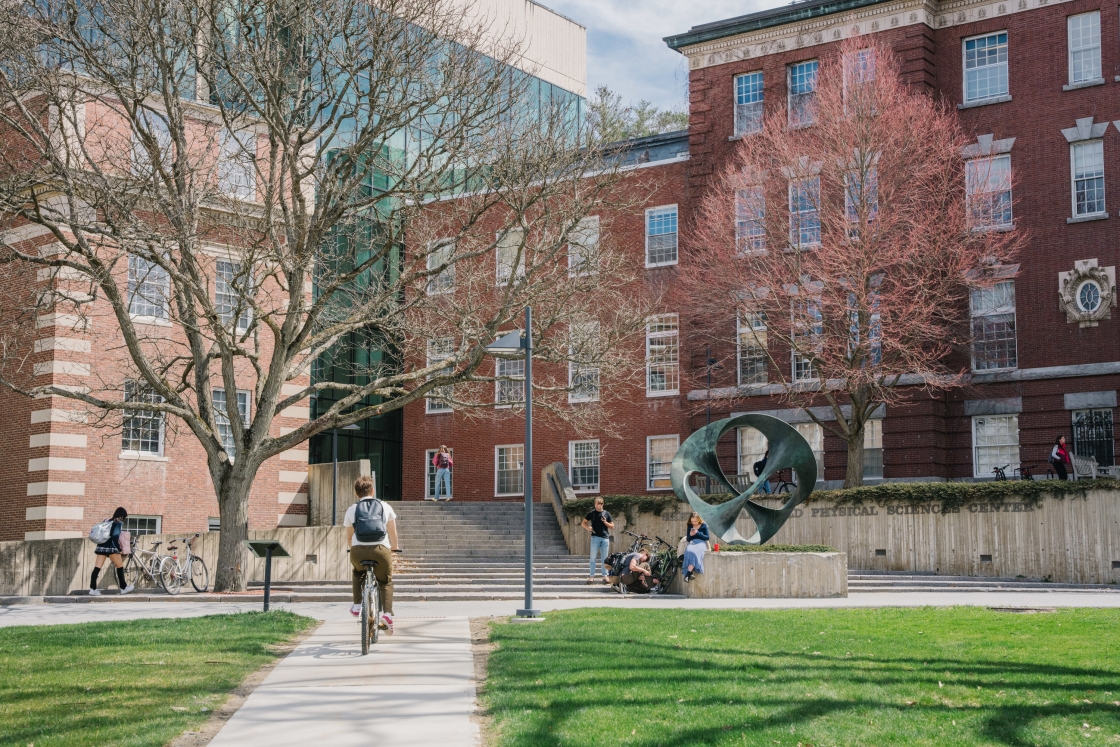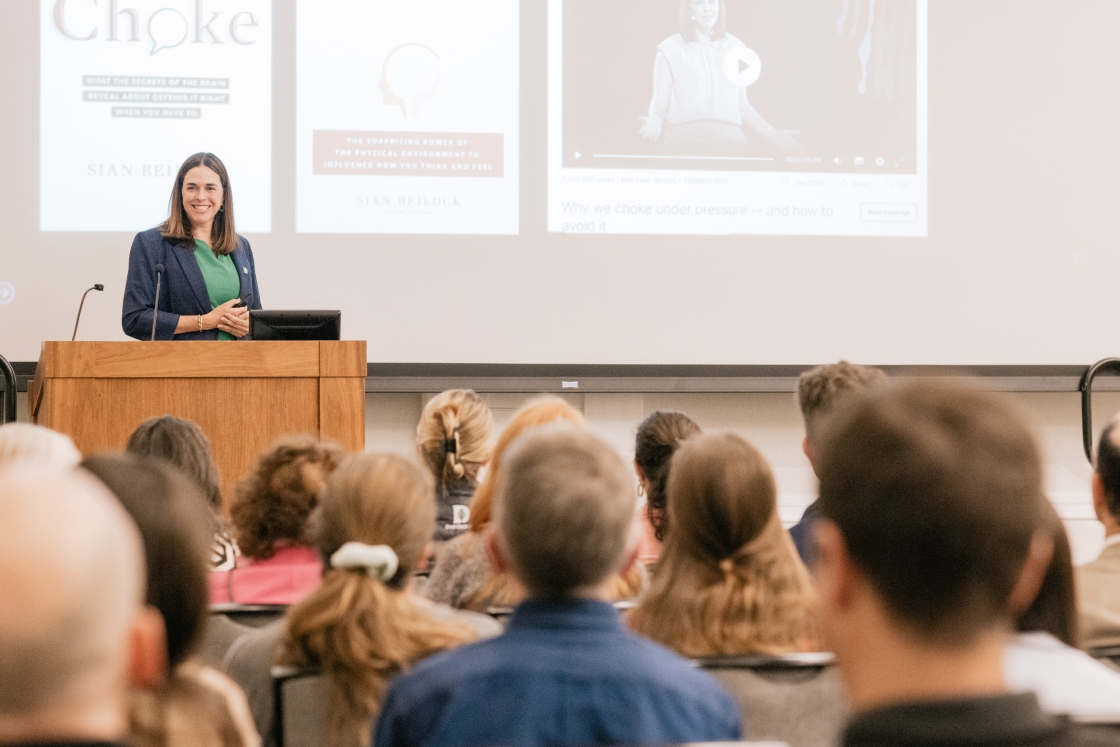For the third consecutive year under the leadership of President Phil Hanlon ’77, the Dartmouth community has supported the College’s institutional priorities at record levels to provide students with expanded, innovative learning opportunities.
New gifts and commitments in fiscal year 2016, which closed at the end of June, totaled $318.8 million, a 2.8 percent increase over the previous year and a 74 percent increase over the previous five-year average of $183.6 million.
Major gifts in support of teaching and faculty research, student financial aid, and a variety of projects to expand experiential learning opportunities highlighted the year. Overall philanthropy reached a new high-water mark, and annual giving was strong across campus, including Thayer School of Engineering, the Tuck School of Business, and the Geisel School of Medicine.
“Alumni, parents, and friends are propelling Dartmouth’s efforts to prepare global leaders through experiential learning, innovative interdisciplinary academics, and outstanding liberal arts offerings,” says President Hanlon. “I am profoundly grateful for this unprecedented philanthropic support.
“We have an ambitious vision to think big, to create knowledge, and to graduate men and women who can play leadership roles in solving the world’s most pressing problems,” he says. “Through gifts small and large, the entire Dartmouth community is providing this institution with the resources needed to make a powerful difference in the world.”
Through total gifts of $318,874,808, donors touched the lives of students across campus, enhancing classroom instruction, research opportunities, and more. Here are the philanthropic highlights of fiscal 2016:
Academic Clusters Addressing Global Challenges
Dartmouth will create 10 interdisciplinary academic clusters, each proposed by faculty members to address a specific global challenge. This $150 million investment, which includes gifts from the previous two years, will bring 30 new faculty to the College, amplifying communities of scholarship and dramatically expanding research opportunities for faculty, undergraduates, and graduate students.
Faculty members across disciplines expressed excitement over opportunities the various clusters are creating for teaching, research, and the discovery of new knowledge. Andrew Bernard, the Jack Byrne Professor of International Economics, says that the new cluster that is focused on the challenges and opportunities of globalization will catalyze outstanding work.
“The globalization cluster exemplifies the interdisciplinary power of the cluster concept,” he says. “It’s already enhancing the work of Dartmouth scholars who research trade, globalization, and economics. The level of integration between the different departments—Tuck, economics, government—is increasing, and we are very excited about the role the outstanding first hire in the cluster, Professor Treb Allen in economics, will play.”
Thayer School
Barry MacLean ’60, Thayer ’61, and his family made the largest single commitment ever to the engineering school, a foundational $25 million gift toward the expansion of Thayer. MacLean was joined by all of his fellow members of the Thayer Board of Overseers in committing more than $61 million to seed investments in additional faculty and new facilities at the school. Thayer aims to deepen its strengths in energy and engineering in medicine. With growing interest from undergraduates, the expansion also intends to accommodate rapid growth in the number of engineering majors, as well as serve more non-engineering majors who want to take courses at Thayer.
House Communities
Private gifts have also supported the planning, preparation, and programming of six house communities for the 2016-17 academic year. The communities emerged from recommendations in the Moving Dartmouth Forward initiative in 2014 and have been designed by faculty and student leaders over the past 18 months. In an effort to provide greater continuity and community while fostering faculty and student interaction outside of the classroom, all Dartmouth students are assigned to a house community.
A number of private gifts enabled the launch of capital projects in support of curricular and co-curricular experiences, including greater opportunities for experiential learning. A few of these:
Hood Museum of Art
The College has broken ground on its landmark $50 million expansion and renovation of the museum. Through the end of June, $40.5 million had been committed toward the project. When the Hood reopens in 2019, it will be a more dynamic teaching museum; it will be 50 percent larger, with five new galleries, three times more object-study space for students, and a striking new entrance to allow the museum to serve as a vibrant social hub for the community as well as a teaching space.
Moosilauke Ravine Lodge
Through a challenge grant, George “Skip” Battle ’66 and his children, Daniel ’01 and Emily ’05, invited the Dartmouth community to raise $10 million toward reconstruction of Moosilauke Ravine Lodge. The challenge garnered more than $8.7 million by the end of the fiscal year. In response to this strong level of support, the College board of trustees approved beginning construction of the new lodge in September, after the conclusion of first-year trips. The lodge is expected to open in the fall of 2017 to welcome the Class of 2021.
Athletics
Dartmouth received more than $25 million in gifts and commitments to construct and endow a state-of-the-art indoor practice facility that will strengthen the College’s ability to recruit outstanding coaches and student-athletes and allow teams to practice year-round. Currently, athletes in many sports must share a single facility, Leverone Field House, which limits their opportunity to practice.
Financial aid
Forty-four percent of all undergraduates received financial aid during the past year, with more than half of that provided by donors to the Dartmouth College Fund. Total giving to the fund came in at $44.9 million, with 42 percent of all alumni participating.
Dartmouth fundraising benefits from a tradition of exceptional volunteer leadership. Two classes dramatically raised the bar for reunion giving. The Class of 1991 gave $8.1 million, setting a Dartmouth record for a 25th reunion class gift. The Class of 2000 established an Ivy League record for a class celebrating its 15th reunion, with contributions totaling $1.21 million.
Donors added more than $71 million to the endowment in the 2016 fiscal year. In addition to supporting the cluster professorships, these funds will support, in perpetuity, a range of activities, including scholarship support, research, course and curriculum development, coaching positions, fellowships, and more. Membership in the Bartlett Tower Society, which acknowledges alumni and friends who support Dartmouth through their estate plans, grew to 1,715 living members, a historic high.
Alumni also expressed their support for Dartmouth through another year of well-attended reunions. Nearly 3,800 alumni returned to campus in June for reunions, which included the dedication of the Class of 1966 Bunkhouse at Mount Moosilauke.
Alumni and friends gave generously to all three professional schools. Geisel received $1 million in annual giving. Thayer received a record $1.6 million in gifts to its annual fund, and Tuck Annual Giving recorded $7.1 million, with more than two-thirds of Tuck alumni participating.


